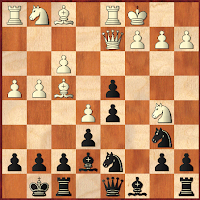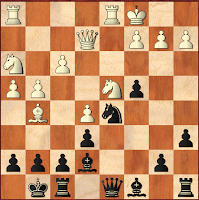Archive for the ‘A Team’ Category
Keith Arkell Visits East Cheshire
East Cheshire member plays Nigel Short
All standard book until my 10. … g6. The book move is Nf8 but I decided it was good tactics to block Short’s Bishop and Queen and move out of book (I had a plan!)
Attacking with the Modern Defense
Taming a GM
Playing in the Stockport Chess League we don’t meet many Grandmasters but new member Sean Hewitt did once hold seasoned GM Mark Hebden to a draw. Sean describes how he did it:
Surviving a storm

18. Qc5 (Fritz still reckons Bxg5+ should be played first)
Killing the King’s Indian
Last summer our number 1 board John Reed showed us his system against that pesky King’s Indian. Just to prove that he practises what he preaches here is a recent crush against a strong opponent. Comments by John.
So another King’s Indian bites the dust thanks to John’s unusual system. Just be prepared to play sharply if you want to get the best out of it!
Double Discovered Check
I played 12. … a6 but 12. … Ne5 would have ruined his kingside pawns.
Another victim of the system
A Tudor Triumph
Just to cheer up the B team after being denied their match last night here is Tudor showing us all how to swindle again Denton last month. Notes by Tudor.
T Rickards 1 J Lysons 0
1. e4 …e5
2. Nf3 …d6
3. Bc4 …Be7
4. O-O …Nf6
5. Re1 …0-0
6. c3 …a6
7. d4 …e x d
8. c x d …Nc6?! (don’t like this now, must find a better move)
9. h3 …b5
10. Bb3 …Bb7
11. Nc3 …h6 (shows B is running out of decent moves)
12. e5! ..dxe
13. dxe …QxQd1
14. RxQd1 (black in some trouble).
…Nh7
15. R1d7 (wish I was White)
…Bd8
Instructive. White completely in charge but needs to find best plan. I suspect gradual strangulation. Black has to, well, just hang in there
16. Bf4 …Bc8
17. Rd2 …Be6!? (I like it. What else? )
18. Nd5?! ( Looks strong. Ducks the obvious 18 B x B with severe B p weaknesses to avoid (doubtful) F file counterplay? )
18. …Na5
19. Rc1? Loses. In pursuit of a win down the c file stuffs himself. Ra1d1retains probable win
19 …c6! (thank you, white)
Nothing to do. Black forces material gain.
20. Nb4 …B x Bb3 and wins comfortably. White quickly finds a few more moves to lose more quickly before the endgame.
Lesson: …Nf6 is rarely played in Philidor’s defense. Game shows one reason why. If offered a simplification to a v good endgame, take it.
Keven the Najdorf Killer!
K.R.Holton v. D Toole
East Cheshire B .v. Denton
Board 2
25th March/2009
1. e4 (I had a panic attack about his battle tested Kings Indian v. my new Reti!)
1. … c5 (I hope he doesn’t know the Sicilian as well!)
2. Nf3 (Martian logic says if you play something you don’t know make sure you really don’t know it – hence the open Sicilian!)
2. … d6
3. d4 c/d
4. Nx d4 Nf6
5. Nc3 a6
6. Be3 e5 (Hmm he does !?…)
7. Nb3 Be6 (Mum I want to go home now!)
8. Be2 Be7
9. 0—0 Nbd7
10. f4 Qc7
11. f5 Bc4 I didn’t like f/e5 and I felt a King-side assault was my best chance
12. Bxc4 Qxc4
13. Nd2 Qc6 Fritz gives Black 0.34 at this stage but I’m still punching.
14. Qf3 Rc8 I was surprised by this expecting Nc5 keeping 0-0-0 in reserve
15. g4 ! h5 ! After the game my opponent graciously told me g4 “was an “awful move”
16. h3 h/g
17. h/g Rh4 Looks good to me, a really Tudor type slugfest. I need a good cuts man !
18. g5 Nh5?? I had thought for 20 minutes cogitating his Ng4 where after Qg3 he had Nxe3 and then after the sequence Qxh4 Nxf1 Rxf1 I was loose but with K side pressure. I think the move played loses a piece to a pawn.
19. Bf2 ! Bxg5
20. Bxh4 Bxh4 ? The Martian mind scrambler I keep down my inside leg ( no not from one of those films Jackie Smith’s house husband watches !) has done the trick he had to play Bxd2 to have any worthwhile counter play.
21. Qxh5 Qb6 +
22. Kg2 Qe3 Oh No! — he’s up to something, why did I cheapskate with ‘Pound Shop’ batteries in the mind scrambler………….. Pleased I played g2 to hold f2 though.
23. Qxh4 Rxc3 ?! Phew mind scrambler still working what is this? I had expected Qxd2 when Rf2 held well and allowed me to attack with Qh8+. Hasn’t he given me enough material?
24. b/c Qxd2+ No perpetual here Sunny Jim !
25. Rf2 Qxc3
26. Rd1 Nf6
27. Rxd6 Ke7 Otherwise Qh8+ and mate with Qd8
28. Rf-d2 g5 A desperate shot but Nxe4 forking both rooks and the queen is not on.
29. Qxg5 His flag had fallen to deprive me of mate in two………..
I politely said I wanted to avoid his KI so played e4 “off the cuff” and didn’t know it. “It showed “ he added rather sagely…………….



